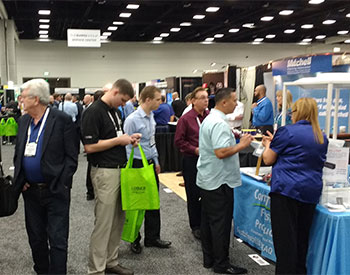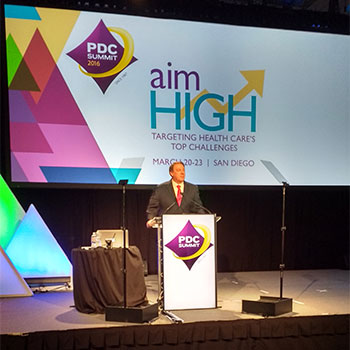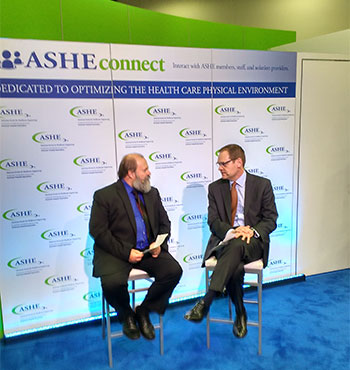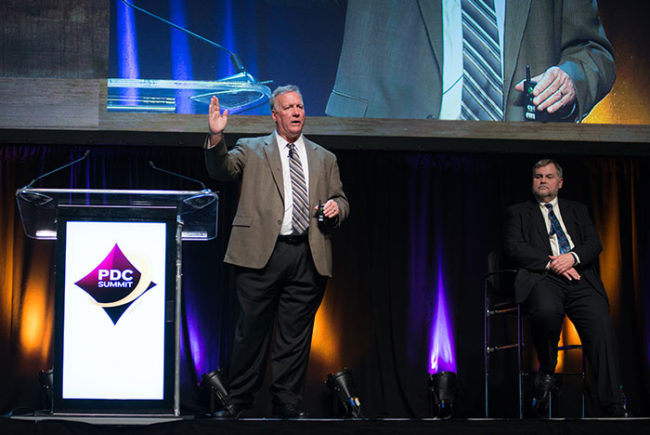More than 3,200 health care facility professionals attended the International Summit & Exhibition on Health Facility Planning, Design & Construction March 20–23.

This year's summit featured more than 200 exhibitors.
More commonly known as PDC Summit 2016, professionals from across health care facility disciplines gathered at the San Diego Convention Center for a range of educational sessions on the latest planning, design and construction strategies and innovations. The event is sponsored by the American Society for Healthcare Engineering (ASHE).
The conference also provided attendees with the chance to see some of the latest technology, products and services in the market at the bustling trade show featuring an estimated 210 exhibitors. Networking opportunities were plentiful at the show.
During his keynote address on how to improve the patient experience, Jake Poore, president and chief experience officer, Integrated Loyalty Systems, Orlando, Fla., related how it is essential for health care organizations to develop a culture that is patient-driven.

ASHE President Terry Scott delivering opening remarks.
He also drew on his 20 years at the Walt Disney World Co. where he helped to recruit, hire and train their 65,000 employees in creating memorable experiences for customers. He had launched the Disney Institute, where he worked with large health care organizations in cultivating patient-driven environments, before establishing his own company.
The impact of the built environment on infection prevention was noted during a panel discussion about a recently launched three-year initiative on how to improve infection prevention strategies.
ASHE, the Centers for Disease Control and Prevention, and the Health Research & Educational Trust of the American Hospital Association are collaborating on the initiative.
The goal is to strengthen infection prevention and control in targeted acute care hospitals to reduce the number of health care-associated infections, which remains a challenging issue for health care. ASHE’s role is to provide guidance on hospital design and its impact on infection prevention.

Tim Adams, director of member professional development, ASHE (left), and Tim Scott, North American sales Manager for Caterpillar Energy Solutions at an ASHE Connect session.
ASHE is seeking input from health care organizations and others who want to share design and operation ideas and best practices for infection prevention and control. Visit its website to share information and ASHE will contact you.
The American College of Healthcare Architects (ACHA) named Northwestern Memorial Hospital, Chicago, the 2016 Legacy Project Award winner. Opened in 1999, the $580 million hospital serves as a replacement facility for inpatient and ambulatory care facilities, ACHA states.
As one of the first high-rise hospitals, Northwestern Memorial successfully has integrated into a dense urban environment, where it offers a range of health care services and retail stores for the community, according to ACHA.
As part of ASHE’s ongoing effort to engage aspiring young health facility professionals, more than 50 students and advisers from universities attended this year’s conference.
Many in the group participated in the American Institute of Architects/Academy of Architecture for Health Student Planning + Design Challenge in which students had 48 hours to create designs for an outpatient surgery center. The work was displayed in the Tech Lounge, a new feature at this year’s conference.
The 2016 Vista Award winners were recognized during the opening ceremony at the conference. SSM Health St. Mary’s Hospital, Jefferson City, Mo., was the winner in the category of new construction for building a new hospital and medical office building.
Virginia Commonwealth University Medical Center in Richmond was the winner of the renovation category for the expansion and renovation of its emergency department.
Carolinas Medical Center–Pineville, Charlotte, N.C., won the infrastructure category for construction of a new central utility plant needed for growth at the medical center.





